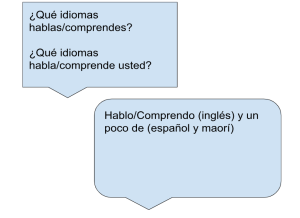26
¿Qué idiomas hablas/comprendes?

Grammar A
| hablar = to speak | comprender = to understand |
| (yo) hablo I speak | (yo) comprendo I understand |
| (tú) hablas You speak (informal) | (tú) comprendes You understand (informal) |
| (él) habla He speaks | (él) comprende He understands |
| (ella) habla She speaks | (ella) comprende She understands |
| (usted) habla You speak (formal) | (usted) comprende You understand (formal) |
| (nosotros) hablamos We speak | (nosotros) comprendemos We understand |
| (vosotros) habláis You all speak (informal) | (vosotros) comprendéis You all understand (informal) |
| (ellos/ellas) hablan They speak | (ellos/ellas) comprenden They understand |
| (ustedes) hablan You all speak (formal) | (ustedes) comprenden You all understand (formal) |
Any time you come across a verb where the infinitive ends in -ar or -er, the verb will be put together (conjugated) in the same way. Remove the ending from the infinitive and replace it with one of the endings shown in bold type (depending on who is performing the action). The pronouns shown in brackets will only be required if you wish to add emphasis to what you are saying, or if there is the potential for any misunderstanding as to who you may be talking about.
The words for languages are the same as the masculine nationalities.
eg: Hablo francés y alemán.

Exercises A
Ej 1 ¿Qué idiomas hablan las siguientes personas?
- Soy de Australia. Hablo ….
- Soy de Alemania. Hablo…
- Ustedes son de Italia. Hablan….
- Soy de Japón. Hablo …
- Somos de Argentina. Hablamos …
- Henry es de Inglaterra. Habla….
- María y Pierre son de Francia. Hablan…
- Eres de China. Hablas….
- Sois de Suiza. Habláis…
- Usted es de Brasil. Habla….
Pronunication
r
The letter r represents a sound similar to English tt in butter, better, or dd in English rudder, riddle. The tip of the tongue goes up to the roof of the mouth, taps once quickly, and comes down again.
para cara toro moro cero muro puro tocar estudiar escribir
rr
The double r is pronounced not with a single flap of the tongue against the roof of the mouth, but with several flaps in rapid succession, producing a sound like a child’s imitation of a motor engine. This sound is also represented by the single letter r at the beginning of a word, and after the letters n or l. If you have trouble pronouncing this sound, try curling your tongue slightly back and up to touch the roof of your mouth. With the tongue still touching the top of your mouth, blow out until the tongue begins to vibrate.
carro tarro corro gorro guerra tierra rata rico rey rebelde